Writing and Recording a Huge #1: Inside Adele’s “Hello” with Producer Greg Kurstin
You can’t escape it – so you may as well just give in.
Yes, we speak of “Hello” by Adele. It’s one of those tracks that arise, and suddenly is absolutely everywhere. From the grocery store to Starbucks, local radio and your car stereo, we guarantee you’ll hear it again soon.
When a single moves all others aside, as “Hello” has done, there’s just gotta be a reason. Adele’s incredible performance is at the center of it all, of course. In the verses, it stands among the most intimately vulnerable vocals ever recorded – experience it in headphones and it’s just you and Adele, alone together, intertwined and extremely exposed.
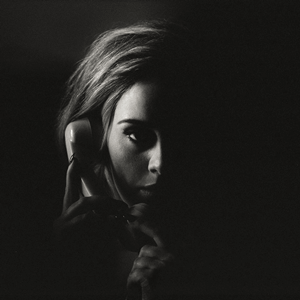
Adele’s “Hello” has been a record that sets records.
But then comes the chorus, massive beyond belief. That’s where Adele unleashes absolutely everything she’s got, going primal as she grieves, “Hello from the other side/I must have called a thousand times/To tell you I’m sorry for everything that I’ve done/But when I call you never seem to be home/Hello from the outside/At least I can say that I’ve tried/To tell you I’m sorry for breaking your heart/But it don’t matter it clearly doesn’t tear you apart anymore.”
The piano gives “Hello” even more power. It’s the supporting co-star in an epic arrangement that’s proven to be one for the ages.
Don’t comprehend “Hello’s” massive impact? Here are some truly stellar stats: Not only did the song hit #1 in 28 countries, it was the first record to exceed 1 million digital sales over a seven-day period. “Hello” spent 10 consecutive weeks atop the Billboard 100, took the shortest time to 1 billion YouTube views (88 days), and powered Adele’s album 25 to 8 million+ sales as of early February – just the sixth album released since 2001 to hit that mark.
An essential element in making “Hello” happen was the song’s co-writer and producer, Greg Kurstin, whose historic success with Adele was anything but a fluke. His path to co-creating the track was borne over decades, starting as a jazz musician in his hometown of LA, which led to forming the duo Geggy Tah which broke through with the offbeat ‘90’s hit “Whoever You Are.”
In the early 2000’s Kurstin became officially obsessed with songcraft. His discography has grown nonstop since then to include Sia, The Bird and the Bee, Beck, The Flaming Lips, Lily Allen, Foster the People, The Shins, Pink, Ellie Goulding, Katy Perry, Lana Del Rey, and Kelly Clarkson – 2012’s 2X-Grammy nominated “Stronger (What Doesn’t Kill You)” was his first #1. Another powerful production was Tegan & Sara’s 2013 release Heartthrob, a creatively and commercially successful partnership that led to their reteaming on their new album Love You to Death, due out on April 8th.
But even though his efforts have netted five Grammy nominations and 60 million+ album sales to date, Greg Kurstin never got cocky. So when “Hello,” which was mixed by Tom Elmhirst and mastered by Tom Coyne of Sterling Sound, detonated across the soundscape, he was amazed as anyone. But he was there in Metropolis Studios, alone with Adele when she recorded the masterpiece. Perhaps at the moment her voice exploded into the microphone, he caught a glimmer of what was to come.
Read on to experience Kurstin’s journey with what now stands as Adele’s signature hit — from the writing to the recording at London’s Metropolis Studios, and the slightly unreal aftermath.
Your career has followed an arc that anyone would want to emulate. Has it felt like a natural progression to you?
It’s unlike anything I’ve ever experienced before. I’ve had songs that did well, but nothing like this one. It’s a great feeling. It’s one of those things that you hope for as a professional songwriter and producer, but when it actually does happen it’s crazy.
But I can’t say it’s been a fast track. It’s been very slow, gradual, kind of one-thing-after-another, which is great. I wouldn’t have it any other way. I’ve experienced different parts of the music world from being a jazz musician playing in jazz clubs, to recording, being in a band, being on a label, touring, and recording as a studio musician.
People come up to me and say, “How did you get to where you are now?” I respond that I wouldn’t recommend the route I’ve gone. It’s been a long road. But it’s been amazing, and I’ve kept going.
You produced/co-wrote three songs on “25” — “Hello,” “Water Under the Bridge,” and “Million Years Ago.” How did you come to be working with Adele on this record?
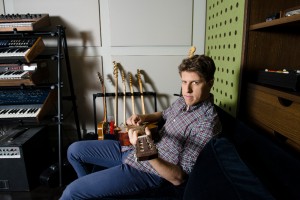
Greg Kurstin found the perfect zone with Adele.
I had gotten to know Adele’s manager, Jonathan Dickins, a little bit over the years, and when it came time to be working on 25, he got in touch and said, “Maybe we can make something happen.” It happened to be a great timing for both Adele and me. We started to write “Hello” around August 2014.
“Water Under the Bridge” was the first song we did together. Then, “Hello” started with the two of us in a Metropolis Studios writing room together, with me playing chord progressions on a MIDI piano. We got into a groove, but then we wanted to try something different, so we switched to the grand piano in the big studio at Metropolis.
I started laying the chords down for “Hello” while she was singing. Then we brought it back into the control room, where we came up with a verse for the song and a temporary chorus that we didn’t think was right. Then I didn’t really talk to her for six months! I was at home in LA, doing my thing when I got a call to come back and continue writing with her. Then we started working on choruses until we found the final one, and that was it.
How did you hit on that chorus?
We tried a lot of different ideas. I think it was just one of those things with us jamming in the room, trying different chord progressions. When something clicked, it really clicked.
Did you feel like you had a hit on your hands then?
No, I had no idea about that. Even up to the very end, I wasn’t sure. Adele and her manager seemed very happy about it, especially the verse in the beginning, it felt like there was something special there.
I thought, “That’s good, maybe it will make the album.” I didn’t think it would be the first single. Sometimes I’m so close to it, I can never really tell. I didn’t think it would be a home run. It’s just so unpredictable, really.
How was the track recorded?
I recorded everything myself, it was just me and her in the room. The engineer (Liam Nolan, see sidebar below for more details on the piano recording) set up all the mics, then he left.
That’s what I do normally. Often when I’m working with an artist for the first time, I engineer during the writing as well. While Adele and I were writing, for example, I was sitting at the computer running Logic, tracking her vocals myself. It’s usually quicker for me to do it that way. In my home studio in LA, I have my engineers Alex Pasco and Julian Burg help me with vocals. When I’m writing, it’s quicker for me to be on the computer, pull up some instruments, and engineer as we go.
When we recorded “Hello” at Metropolis, we didn’t have the computer with us in the live room. Adele would be writing lyrics in the control room while I would be running back and forth — what I did was put Logic on loop record, go into the live room and play piano, then run back into the control room and maybe do a few edits. Then we were ready to track Adele’s vocals.
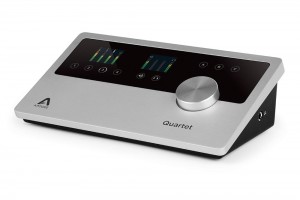
Kurstin used an Apogee Quartet to help capture Adele’s epic vocal performance.
Metropolis has a great Neumann U47, which we then put through a Neve 1073 mic pre and then an LA-2A. I had my portable setup there to record into, which is a very compact situation. Since I’m using Logic, I often don’t bother using the studio’s converters, which can help avoid technical glitches. So the vocal signal path for “Hello” was the U47, a 1073, LA-2A, into my Apogee Quartet, and then finally into my laptop.
How were the other instruments recorded?
There were three mics on the piano (see sidebar below for complete piano recording details). I played a Fender Telecaster Guitar, which went through a Fender Twin, which was recorded with a Shure SM57 and a Royer Ribbon, which was then bus-mixed through the board. The organ and other sounds were done in the box at my home studio.
Besides working with some of the top artists of our time, your music has also been mixed by some of the top mixers working like Manny Marroquin on Tegan and Sara, and more recently, Tom Elmhirst on Adele. What does the mix phase represent for you?
It’s funny, at the beginning Adele seemed to like the demo mix. I always mix simultaneously while I record. There was a while that Adele liked the mix, and I thought maybe that would be the mix.
Then her manager said, “Let’s try a mix with Tom (Elmhirst).” I agreed, because I think it never hurts to try and top it. I mix within Logic, and it’s great, but I like to get it out and see what it’s like when it leaves my environment, because it could help give it a different dimension.
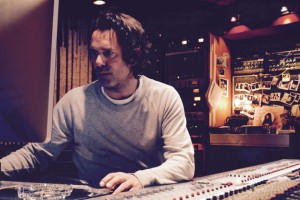
Tom Elmhirst’s mix took “Hello” one step further.
I was really pleasantly surprised with Tom’s mix. Her vocal sounded amazing, very natural – he got a very organic, unprocessed vocal sound with a lot of warmth. He did such a great job on that, and he’s so great on low-end. Tom adds a nice, warm, classic element to his mixes.
The reverb was very subtle. Almost like it’s there, and it’s not there. I like that a lot. I’ve had a lot of people say to me that they really love the way the vocals sound on this recording – he did a terrific job mixing it.
What have you learned about making hits throughout your career – do you know for certain when you’re in the process of writing/producing a hit song?
You know what? I can honestly say that I don’t know when I’m in the process of writing a hit song.
There are times when I can say this has all the ingredients to be a hit song, but I’m never completely sure. I’ve had songs that I thought would be a hit, but then it wasn’t. Then I’m like, “Well, I have no idea what’s going on.”
It’s especially uncertain with a song like “Hello” that doesn’t sound exactly like what’s happening on the radio at this moment. You’re always asking yourself, “Is it too different?” I was going through my fears and doubts. I don’t want to be the one who destroys Adele’s career!
But there’s no formula yet for me. I just try to do the best I can. I listen to pop radio, and find myself analyzing certain things. I feel like I can appreciate any song on the radio, even if it’s not my cup of tea. I can listen and say, “That’s not my kind of song, but those drum sound amazing.” I make a mental checklist, a folder in the internal hard drive in my head, noting drum sounds and keyboard sounds.
I’m always fascinated with why things do well. A hit song has to do with the song and its production, but also the artist, the timing, and the opportunity – it all has to be there.
- David Weiss
Sidebar – Tracking the Piano for “Hello”:
Metropolis Studios engineer Liam Nolan was the only other person present when the recording of “Hello” was birthed into the world.
An expert at recording in the same famed facility where Queen, Michael Jackson, U2, Lady GaGa, Amy Winehouse, will.i.am, The Stone Roses, Lauryn Hill, The Verve, Rihanna, and many more have all tracked, Nolan knew just what to do when Adele and Kurstin wanted to capture Metropolis’ famed grand piano.
“We have a Fazioli F228 here at Metropolis,” Nolan says. “I believe we bought this particular piano because it was Freddie Mercury’s preferred piano at the time. Queen recorded some of their last two albums, Innuendo and Made in Heaven in Studio A and their music video for ‘Headlong’ was shot here around the same time. Here’s the video:
“We are very lucky to have the Fazioli here, and really is a joy to record. We also have a Yamaha C7 in Studio B, which is also great, but personally I do not think it is as rich and warm-sounding as the Fazioli. Sonically and harmonically it’s very rich and characterful, which really lends itself to pop and rock recordings, however because of this it may not be a pure classical pianist’s piano of choice. Of course you can record classical piano on it and it will sound great, but because of its richness it can sometimes be too harmonically complex when recording for some people’s taste.
“For examples of how different and versatile the Fazioli can sound, for a very pop clean sound, Clean Bandits’ ‘Rather Be‘ was recorded with the Fazioli. For a more Jazz sound, Zara McFarlane’s ‘Her Eyes’ was also recorded on the Fazioli and on course ‘Hello’ for a very rich and rounded sound.
“With regards to micing the piano, the three close microphones used were two Sennheiser MKH-40’s and a Neumann FET 47. I also had some room mics setup for some ambience which I believe were a pair of Neumann M147’s.
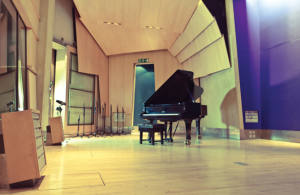
The famed Fazioli piano at Metropolis Studio A.
“The two MKH-40’s were set up as a XY stereo pair and placed just over a foot above middle C. The pre’s used for the MkH-40’s and the M147’s were the Prism Sound Maselec MMA-4’s, mainly because it is a very clean and transparent preamp that doesn’t add much colour.
“After the Prism’s on the MKH-40 signal path, I had the Manley Vari Mu compressor and the GML 8200 parametric EQ.
“Both were doing very little. The Manley was only really reducing by a few dB when working the most. It was used just to glue the mics and just seems to hold things together when running signal through it. The GML was only used to boost the top end around the 10kHz region just to add a bit of air and help define the notes, as sometimes the Fazioli needs a bit of help.
“The FET 47 was placed at the bottom of the piano to add a bit of weight, but to also help bring in the stereo image and help with phase when in with the MKH-40’s.”
— David Weiss
Please note: When you buy products through links on this page, we may earn an affiliate commission.






